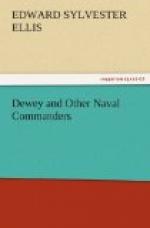The assignment, as has been stated, was not pleasing to Dewey, because he and others believed the real hard fighting must take place in European or Atlantic waters. We all know the uneasiness that prevailed for weeks over the destination of the Spanish fleet under Admiral Cervera. Dewey wanted to meet him and do some fighting that would recall his services when a lieutenant in the Civil War, and he saw no chance of securing the chance on the other side of the world, but Roosevelt was persistent, and, against the wishes of the Naval Board, he obtained his assignment as flag officer of the Asiatic squadron.
Commodore Dewey felt that the first duty of an officer is to obey, and after a farewell dinner given by his friends at the Metropolitan Club in Arlington, he hurriedly completed his preparations, and, starting for Hong Kong, duly reached that port, where, on January 3, 1898, he hoisted his flag on the Olympia.
The official records show that the Olympia was ordered home, but Roosevelt, in a confidential dispatch of February 25, directed Commodore Dewey to remain, to prepare his squadron for offensive operations, and, as soon as war broke out with Spain, to steam to the Philippines and hit the enemy as hard as he knew how. Meanwhile ammunition and supplies were hurried across the continent to San Francisco as fast as express trains could carry them, and were sent thence by steamer to Hong Kong, where they were eagerly received by the waiting Commodore.
Reverting to those stirring days, it will be recalled that the Queen Regent of Spain declared war against the United States on April 24, 1898, to which we replied that war had begun three days earlier, when the Madrid government dismissed our minister and handed him his passports. Then followed, or rather were continued, the vigorous preparations on the part of our authorities for the prosecution of the war to a prompt and decisive end.
Commodore Dewey’s squadron lay at anchor in the harbor of Hong Kong, awaiting the momentous news from Washington. When it reached the commander it was accompanied by an order to capture or destroy the enemy’s fleet at Manila. Almost at the same time Great Britain issued her proclamation of neutrality, the terms of which compelled Dewey to leave the British port of Hong Kong within twenty-four hours. He did so, steaming to Mirs Bay, a Chinese port near at hand, where he completed his preparations for battle, and on the 27th of April steamed out of the harbor on his way to Manila.
The city of Manila, with a population numbering about a quarter of a million, lies on the western side of Luzon, the principal island, with a magnificent bay in front, extensive enough to permit all the navies of the world to manoeuvre with plenty of elbow room. The entrance to the immense bay is seven miles wide and contains two islands, Corregidor and Caballo, both of which were powerfully fortified, the works containing a number of modern guns. Torpedoes were stretched across the channel and the bay abounded with enough mines and torpedoes, it would seem, to blow any fleet of ironclads to atoms as soon as it dared to try to force an entrance into the waters. Some twenty miles beyond lay the city of Manila, and about ten miles to the south was Cavite, constituting the strongly fortified part of the city proper.




